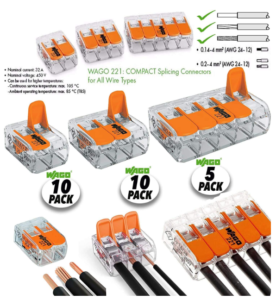A little bit about Wago Connectors and How to use them
The standard solution is frequently to utilise the screw-in electrical connector itself, or even wire nuts and electrical tape, if you need to splice wires together in the field. Although both approaches appear to be effective, there is some technique needed in putting them together. If the wires are too slack, they might not be secure; if they are too tight, you risk injuring the connector or, in the case of wire nuts, having the wires burst out.
Is there really a simpler way, despite the fact that you could believe it to be a necessary evil of the job? A more trustworthy approach? The lever nut-style Wago wire connectors are the unequivocal “yes” to both questions.
How to use Wago Lever Nuts and When Were They First made?
Lever nuts were invented by WAGO, who in 2003 received UL approval for the first such product. Simply cut the wires to the desired length, pull the lever on the appropriate connector up, push the wire into place, then flip the lever back down to use them. For their more recent WAGO 221 series connectors, their blocks are available in two different forms and in 2, 3, and 5 wire formats.
the wire into place, then flip the lever back down to use them. For their more recent WAGO 221 series connectors, their blocks are available in two different forms and in 2, 3, and 5 wire formats.
The older 222 series can handle solid-core or stranded wire between 28 and 12 AWG (.08 and 2.5mm2). Remember that thinner wire is indicated by greater numbers. Connectors have a 20A capacity and a 600V UL listing. There are two different versions of the 221 line. The 12 AWG version is UL approved for 600V and 20A and is compatible with wires between 24 and 12 AWG (.2 and 4mm2). The 10 AWG version is UL approved for 600V and 30A and works with 20 to 10 AWG (.5 to 6mm2).
Although it is possible to find generic 222-style lever nut connectors, WAGO is such a market leader that the phrase “WAGO connector” is generally used as a general term. The WAGO 221-style nuts, which even when compared to the 222 have several really beautiful qualities, almost a 40% reduction in size, something you often won’t find in the generic form.
How to use Wago 221 Connectors?

Over its predecessor, the WAGO 221 series offers a number of significant advantages. First of all, these new connectors take up a lot less room in packed panels thanks to a 40% size decrease compared to the 222 Series. The levers are also made to open and close with less force. While the WAGO 221 series includes two recessed test points on each connector—one in the front and one in the rear, beneath a lever—the WAGO 222 series only has one. Both even offer instructions for how far to remove the wire on the bolts themselves.

The WAGO 221 connector’s transparent housing, lets you see whether your wire is properly positioned inside the clamping compartment, is perhaps its best feature. Both types of connectors are very remarkable inventions that handle a range of wire gauges firmly and effortlessly! The WAGO 222 is rated to hold a finer gauge of wire (down to 28 AWG) when necessary, but the WAGO 221 type offers a number of significant advantages.
Conclusion
To recap, Wago Connectors were created to facilitate splicing without the use of tools. Wago’s clamp technology has a quicker installation process and requires no maintenance. Wago connectors are easy to use, and are great solid, and fine stranded conductors. You will be able to utilise these connectors and know how to use them without any problems with our assistance, and they will last you for a very long time.